Electronic Systems Technology EDG217ES Edge 900 MHz User Manual Radius Amp User s Manual
Electronic Systems Technology Edge 900 MHz Radius Amp User s Manual
Users Manual
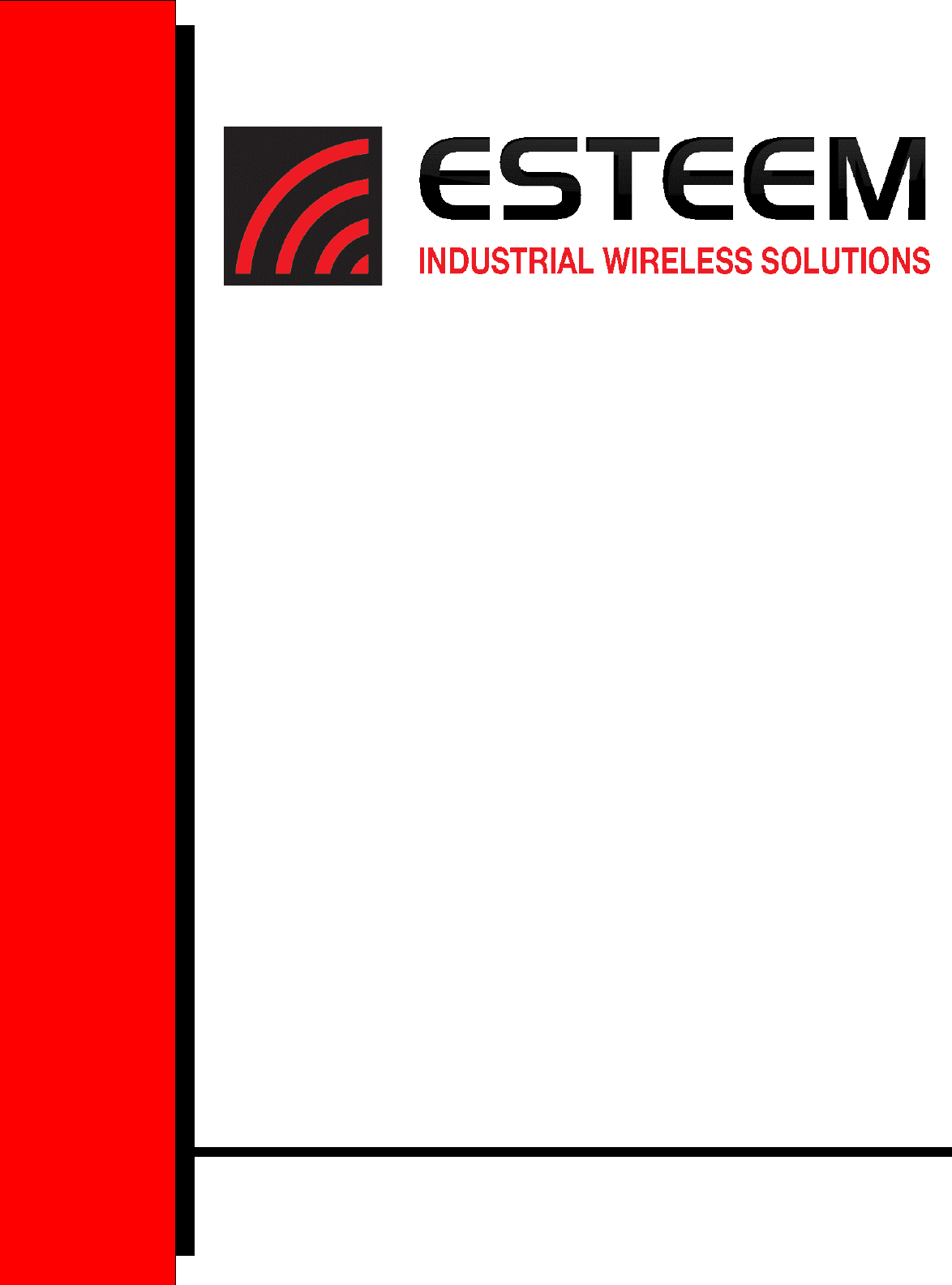
ESTeem Industrial Wireless Solutions
ESTeem User’s Manual
Edge 900
Manual Revision 1.0
January 2017

Electronic Systems Technology, Inc.
dba ESTeem Wireless Modems
415 N. Quay Street
Building B1
Kennewick, WA 99336
Phone: 509-735-9092
Fax: 509-783-5475
E-mail: market@esteem.com
Web Site: www.esteem.com
Copyright© 2017 by Electronic Systems Technology, Inc.
All rights reserved. Printed in the United States of America. No part of this publication may be reproduced, stored
in a retrieval system, or transmitted, in any form or by any means, electronic, mechanical, photocopying, recording,
or otherwise, without the prior written permission of Electronic Systems Technology.
Author:
Date:
Name:
Eric P. Marske
Title:
Product Manager
Approved by:
Date:
Name:
Michael Eller
Title:
President
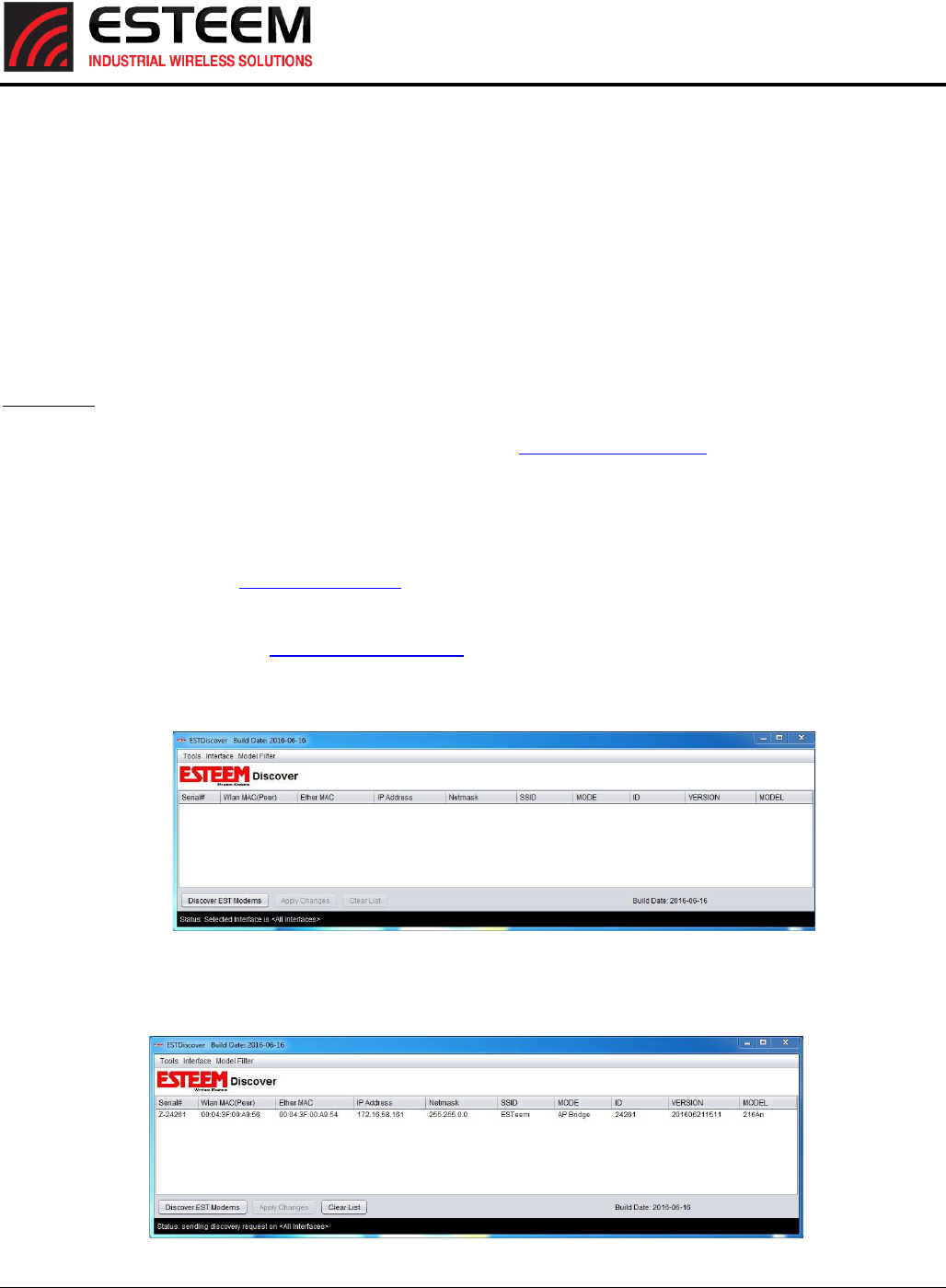
Edge 900
User’s Manual
Revised: 19 Jan 2017 1 of 9
Overview
The ESTeem Edge 900 is a wireless modem (radio) operating in the unlicensed 900 MHz ISM band (902-928 MHz). The radio
can be configured to provide both Ethernet and serial data transparent to the connected device. The configuration of the Edge
900 is very simple in that there are only two modes of configuration as either the Master Bridge or Slave Bridge.
ESTeem Discovery Utility
The ESTeem Discovery Utility will allow you to configure the IP address on the Edge 900 radio to match your network regardless
of its current IP subnet. The Discovery Utility will also allow access to the Edge 900 Configuration Utility for programming and
troubleshooting the wireless network.
Installation
The Discovery Utility can be downloaded from the ESTeem web site (http://www.esteem.com) or is available on the Software
Resource media that was shipped with the Edge 900 radios.
1. The Discovery Utility is a Java™ based application compatible with any computer operating system (Window, Linux, etc).
The application requires two (2) additional support files to operate:
Java – Downloadable from http://www.java.com. The version required will be based upon your operating system.
Note: The installation and updates from Java may try and install additional web browser toolbars. Uncheck the optional
installation if they are not desired.
WinPcap – Downloadable from http://www.winpcap.org/. The version required will be based upon your operating system.
2. Once both the above programs have been installed, save the ESTDiscover.exe file to any location on your computer such
as the Desktop. Double click the ESTeem.exe program and Figure 1 will be displayed.
3. Connect the Edge 900 modem to your computer either directly to the Ethernet card or through a Switch using a CAT-5e
Ethernet cable. The Ethernet port supports Auto-Negotiation, so either a patch cable or crossover cable will work. Press
the Discover EST Modems button.
Figure 1: ESTeem Discovery Utility
Figure 2: ESTeem Discovery Utility
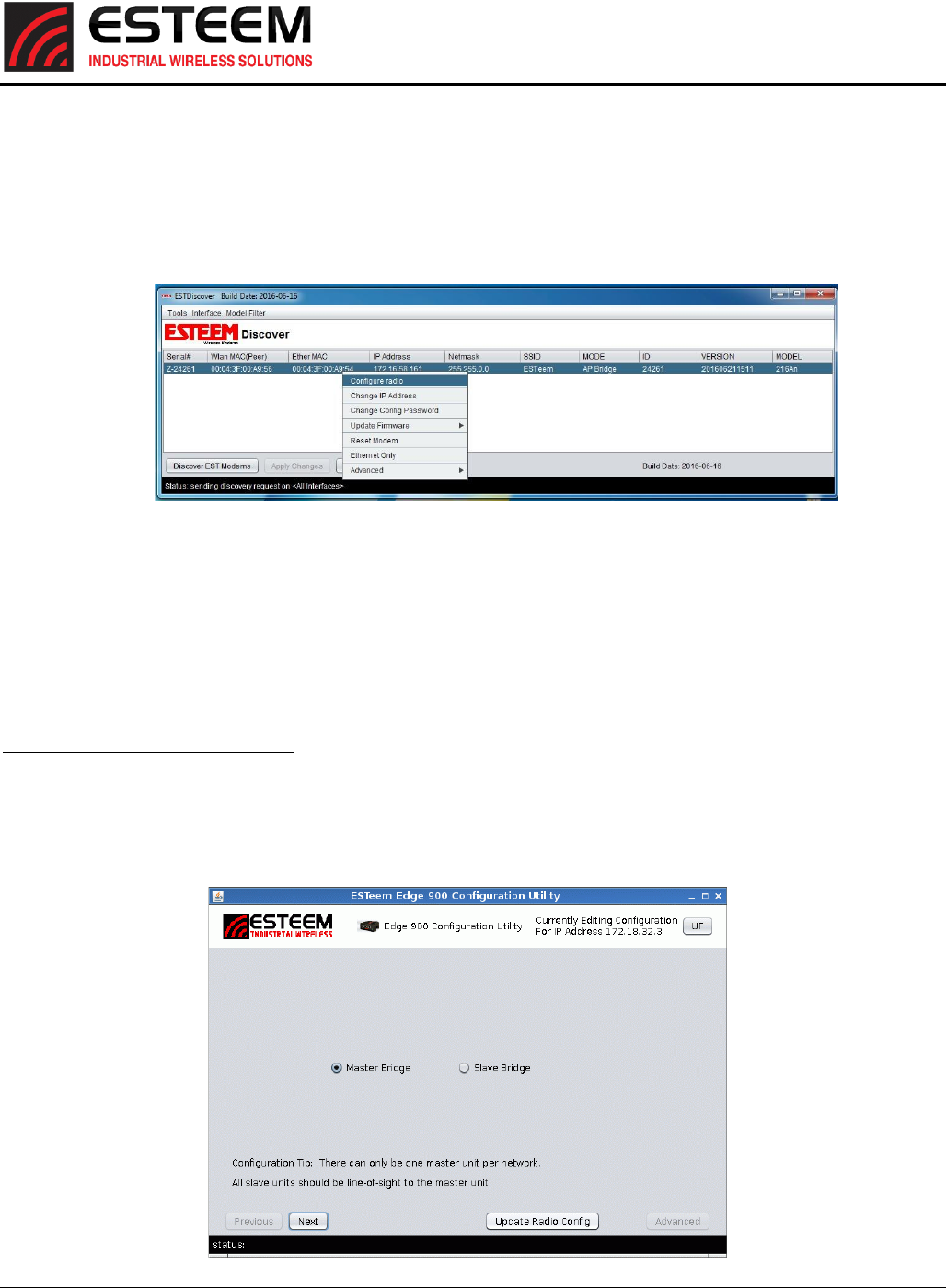
Edge 900
User’s Manual
Revised: 19 Jan 2017 2 of 9
4. The ESTeem Edge 900 will be displayed (Figure 2). If the ESTeem Horizon is not on the same IP subnet as the computer,
double click on the IP, Netmask or Gateway and make the necessary changes. Press the Apply Changes button when
complete.
5. If changes were made to the IP address, you will need to press the Discover EST Modems button again to show the changes.
Right-mouse click on the Horizon and select Configure Radio button to begin programming.
Edge 900 Configuration Utility
The Edge 900 configuration utility will allow programming of the radio for either the Master Bridge or Slave Bridge. Every
network will consist of a single Master Bridge with one or more Slave Bridge radios. The hopping pattern for a unique Edge
900 network is determined by the AES-256 encryption pass phrase set in step 4 of the programing. The following is the
programming procedure for the Edge 900:
Step 1 – Setting Mode of Operation
The Edge 900 will either be configured as the Master Bridge or the Slave Bridge. Every network will consist of a single Master
Bridge and one or more Slave Bridge radios. The network will always be a “hub and spoke” based network with the Master
Bridge in the center (Hub). The first page of the Edge 900 Configuration Utility (Figure 4) will ask if you are programming the
Master or Slave Bridge. Select the mode of operation and press the Next button to continue.
Figure 3: Opening Radio Configuration Software
Figure 4: Step 1 – Mode of Operation
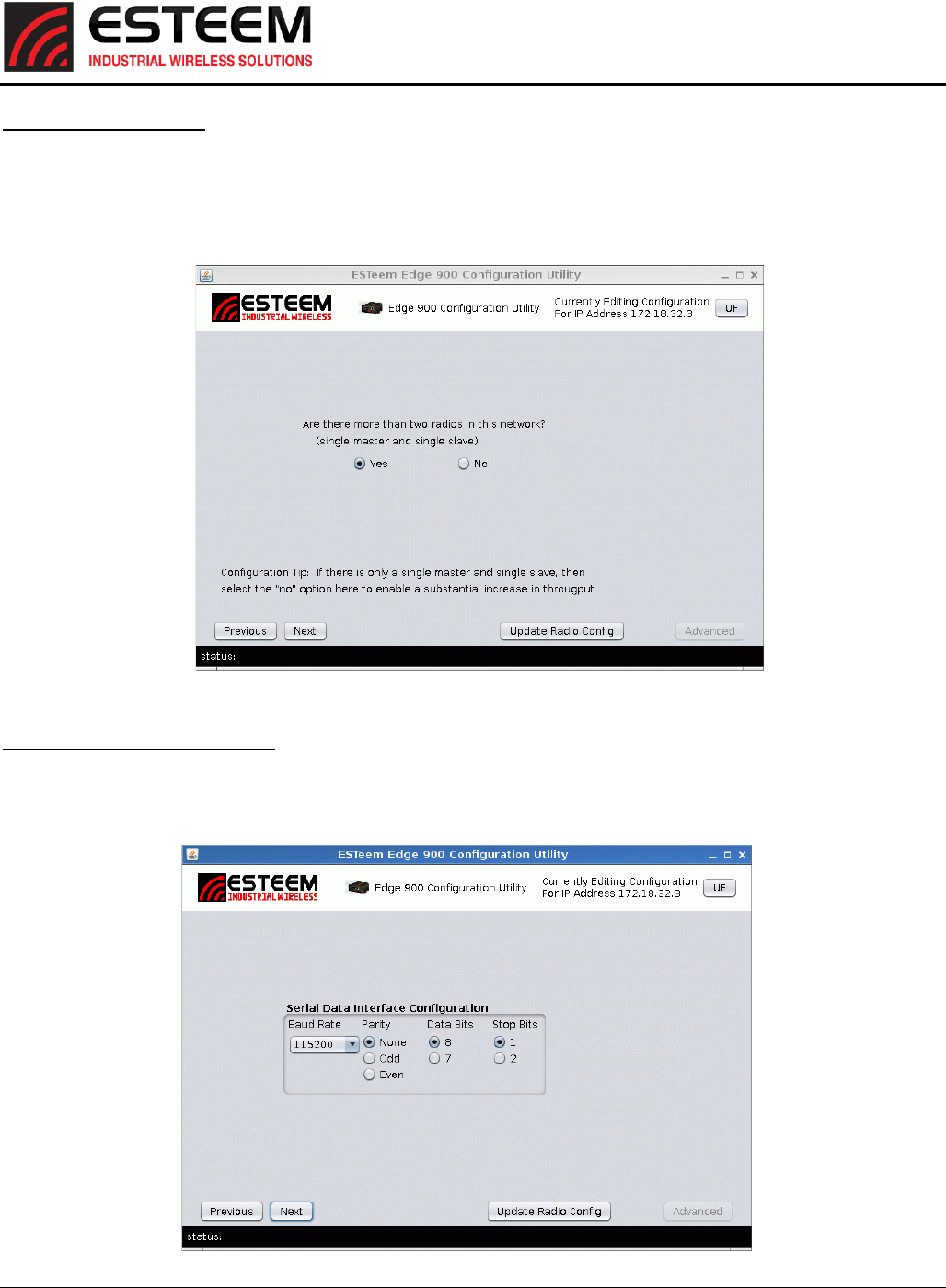
Edge 900
User’s Manual
Revised: 19 Jan 2017 3 of 9
Step 2 – Network Layout
The Edge 900 will operate in either a point to point or point to multipoint configuration. If there is only a single master and
single slave (point to point mode) the Edge 900 can devote all wireless resources to the single remote location and increase
the throughput. If programming a point to point network, select No or a multipoint network select Yes (Figure 5). Press the
Next button to proceed.
Step 3 – Serial Port Configuration
Step three will set the data rate for the serial port on the Edge 900 (Figure 6). Configure to match the connected device or
skip to step 4 if only using the Ethernet interface. Press the Next button to proceed.
Figure 5: Step 2 – Network Layout
Figure 6: Step 3 – Serial Port Configuration
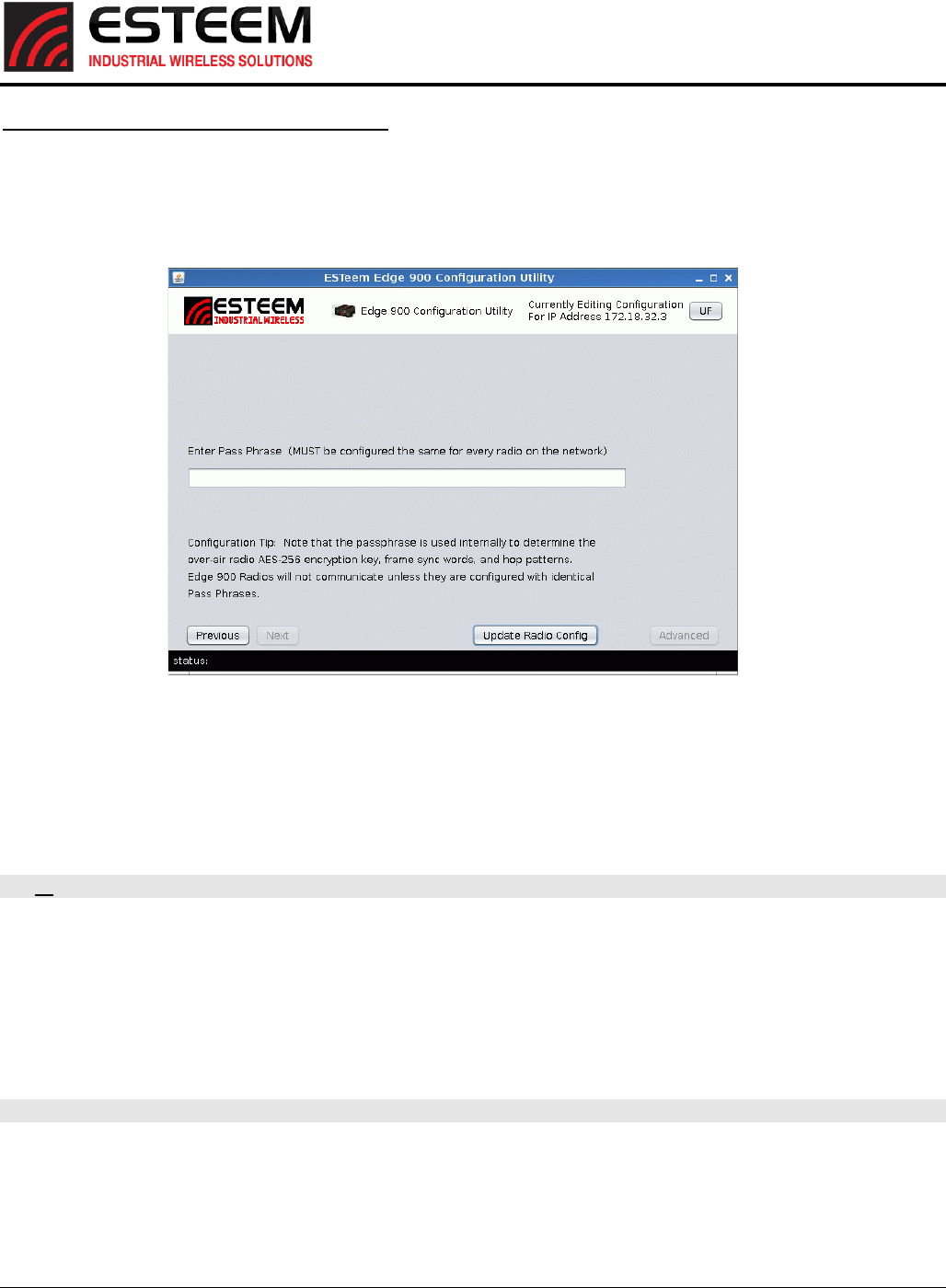
Edge 900
User’s Manual
Revised: 19 Jan 2017 4 of 9
Step 4 – Encryption and Network Identification
The unique identification for an Edge 900 network is the AES-256 passphrase (Figure 7). A unique pass phrase must be
entered to finish the configuration of the radio. The pass phrase must be between 4 and 64 character long and MUST be
identical on all Edge 900 radios in the same network. Enter the network pass phrase and press the “Update Radio Config”
button to program the radio for operation.
Software Commands
Listed below in alphabetical order are the definitions of the ESTeem Edge 900 software commands. All software commands
are entered lowercase.
? or help
help Displays the modem information and sub help menus.
help all Displays all commands switches and arguments.
help radio Displays radio commands switches and arguments.
help interface Displays interface commands switches and arguments.
help setup Displays setup commands switches and arguments.
help system Displays system commands switches and arguments.
cert
This command will display the FCC ID and model number of the amplifier.
Figure 7: Step 4 – Encryption and Network Identification
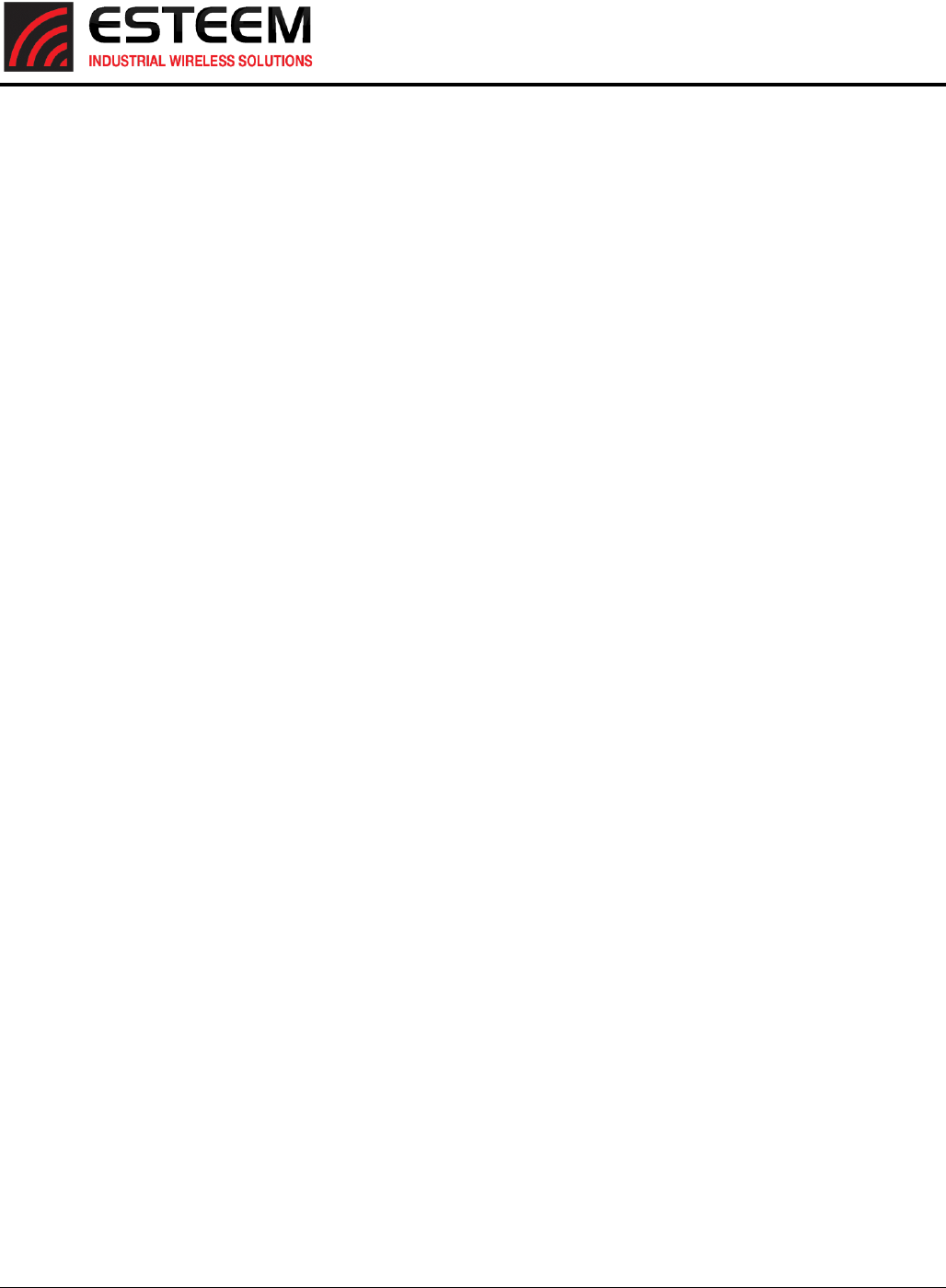
Edge 900
User’s Manual
Revised: 19 Jan 2017 5 of 9
Information to Users
The equipment has been tested and found to comply with the limits for both the FCC Class B digital device (pursuant to Part 15
of the FCC rules) and Industry Canada (IC) CAN ICES-3 (B)/NMB-3(B).
FCC Statement
Operation is subject to the following two conditions: (1) This device may not cause harmful interference, and (2) this device
must accept any interference received, including interference that may cause undesired operation.
Caution: Changes or modifications to this equipment not expressly approved by ESTeem Wireless Modems for compliance
could void the user's authority to operate the equipment.
IC Statement
“This device complies with Industry Canada licence-exempt RSS standard(s). Operation is subject to the following two
conditions: (1) this device may not cause interference, and (2) this device must accept any interference, including
interference that may cause undesired operation of the device.”
“Cet appareil est conforme avec Industrie Canada exempts de licence standard RSS (s). Son fonctionnement est soumis aux
deux conditions suivantes: (1) cet appareil ne doit pas provoquer d'interférences et (2) cet appareil doit accepter toute
interférence, y compris celles pouvant causer un mauvais fonctionnement de l'appareil.”
Emissions Information
Edge 900 MHz (Model 217ES)
HVIN: 217ES
Frequency Hopping/DTS Spread Spectrum Device
(USA) FCC ID: ENPEDG217ES
(Canada) IC No: 2163A-217ES
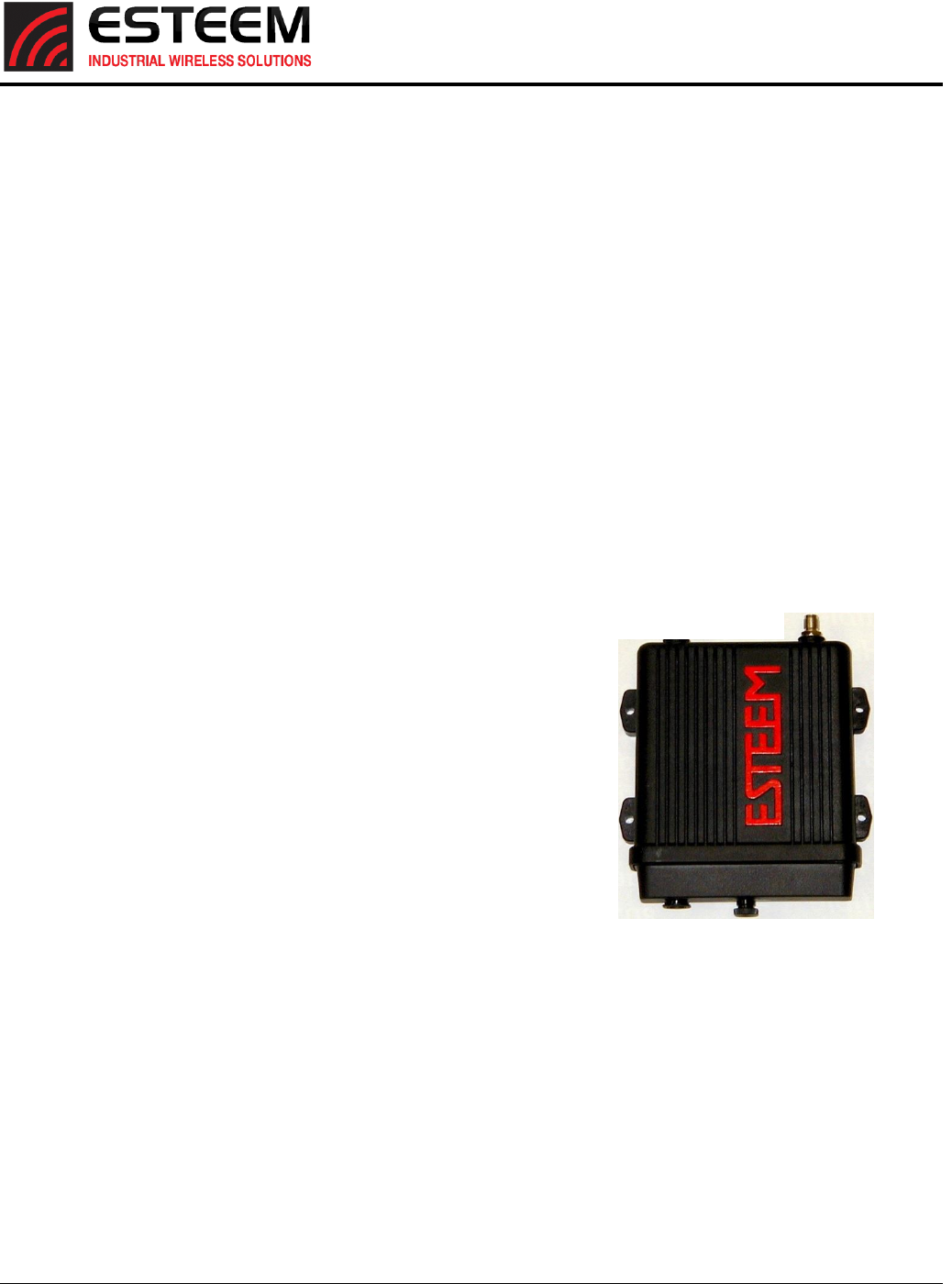
Edge 900
User’s Manual
Revised: 19 Jan 2017 6 of 9
Edge 900 MHz Antenna and Cable Configurations
ESTeem offers different types of antennas for both indoor and outdoor configurations. This device has been designed to
operate with the antennas listed below, and having a maximum gain of 7 dB. Antennas not included in this list or having a
gain greater than 7 dB are strictly prohibited for use with this device. The required antenna impedance is 50 ohms.
This radio transmitter ESTeem Edge 900 MHz (HVIN: 217ES) has been approved by Industry Canada to operate with the antenna
types listed below with the maximum permissible gain and required antenna impedance for each antenna type indicated.
Antenna types not included in this list, having a gain greater than the maximum gain indicated for that type, are strictly
prohibited for use with this device.
Le present emetteur radio ESTeem HVIN: 216AD a ete approuve par Industrie Canada pour fonctionner avec les types d'antenne
enumeres ci-dessous et ayant un gain admissible maximal et l'impedance requise pour chaque type d'antenne. Les types
d'antenne non inclus dans cette liste, ou dont le gain est superieur au gain maximal indique, sont strictement interdits pour
l'exploitation de l'emetteur.
Warning: Only the tested cable lengths and antennas provided by EST meet the FCC and DOC maximum peak output
power requirements. Any other combination of antennas or coax cables is not authorized. To reduce potential radio
interference to other users, the antenna type and its gain should be so chosen that the equivalent isotropically radiated
power (e.i.r.p.) is not more than that permitted for successful communication.
Part Number: AA20DMs
Omni-directional direct mount antenna, 2 dBi gain.
Indoor and outdoor applications.
There must be a minimum separation distance of 23
cm. from the antenna to the user. See Warnings.
Part Number: AA20Es900
Omni-directional external pole mount antenna, 7 dBi
gain with 3-ft. integral feedline and connector.
Outdoor applications.
There must be a minimum separation distance of
23cm. from the antenna to the user. See Warnings.
Part Number: AA203Es900
Directional pole mount antenna, 7 dBi gain with 3-ft.
integral feedline and connector.
Point to point and point to multi-point outdoor
applications.
There must be a minimum separation distance of 23
cm. from the antenna to the user. See Warnings.
Warnings:
Only pre-made coax cables from the factory used in
conjunction with either the AA20Es900 omni-directional and
AA203Es900 directional antennas meet all FCC Section
15.247(b) EIRP maximum power requirements.
Transmit/Receive
Antenna Port
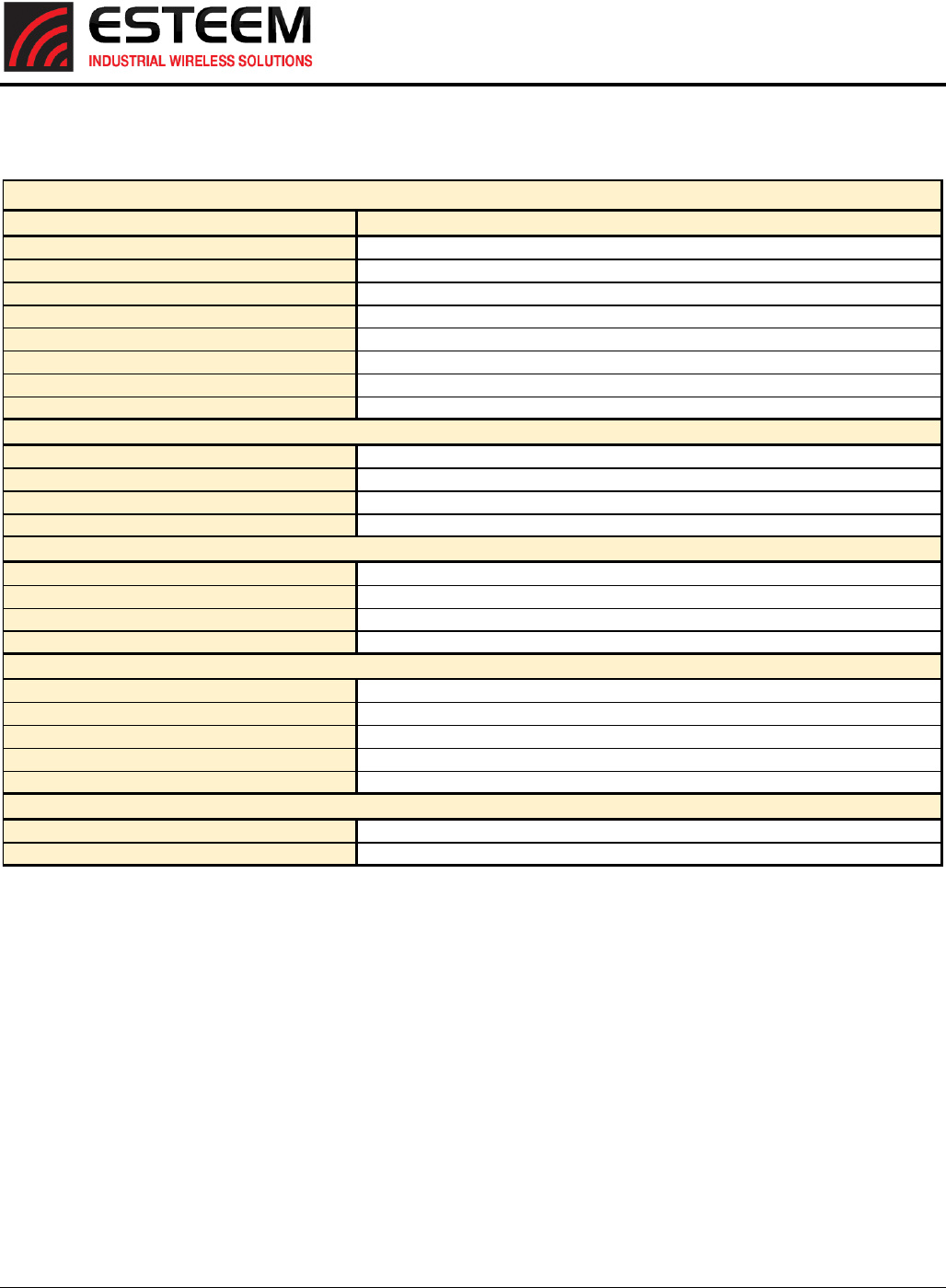
Edge 900
User’s Manual
Revised: 19 Jan 2017 7 of 9
Edge 900 Specifications
Transmiter/Receiver
Frequency of Operation 902-928 MHz
RF Data Rate 1 Mbps
Tx Output Power (Software Selectable) 24dBm
Tx Output Impedance 50 ohms
Rx Sensitivity -97 dBm
FCC Type Acceptance ENPEDG217ES
Industry Canada Type Acceptance 2163A-217ES
LED Indicators Power (On/Off) - Carrier Detect (On/Off) - Transmitter (On/Off) - Reveiver (On/Off)
Power Requirements
Receive 160mA @ 12 VDC
Transmit 700mA @ 12 VDC
PoE Power Supply (IEEE 802.3at,30 watts) (opt)
External Power Input 10 to 16 VDC @ 1A
Input/Output Connectors
Ethernet Port 1 (10/100/1000) RJ-45 Female
RS-232C Comm Port (2,400 to 115.2 K baud) RJ-45 Female
Antenna Input/Outputs TNC Reverse Female
External DC Input Power Mini-Combicon, 3 pin female
Case
Temperature Range -30° to +60° C
Humidity 95% Non-condensing
Dimensions 1.9 in. H x 6.7 in. W x 6.2 in. L
Weight 1.25 lbs.
Product Warranty 1 Year
Other
Outdoor Pole Mt. Kit AA195PM (opt)
PoE Power Supply AA175.2 (opt)
ESTeem Edge 900 Specifications
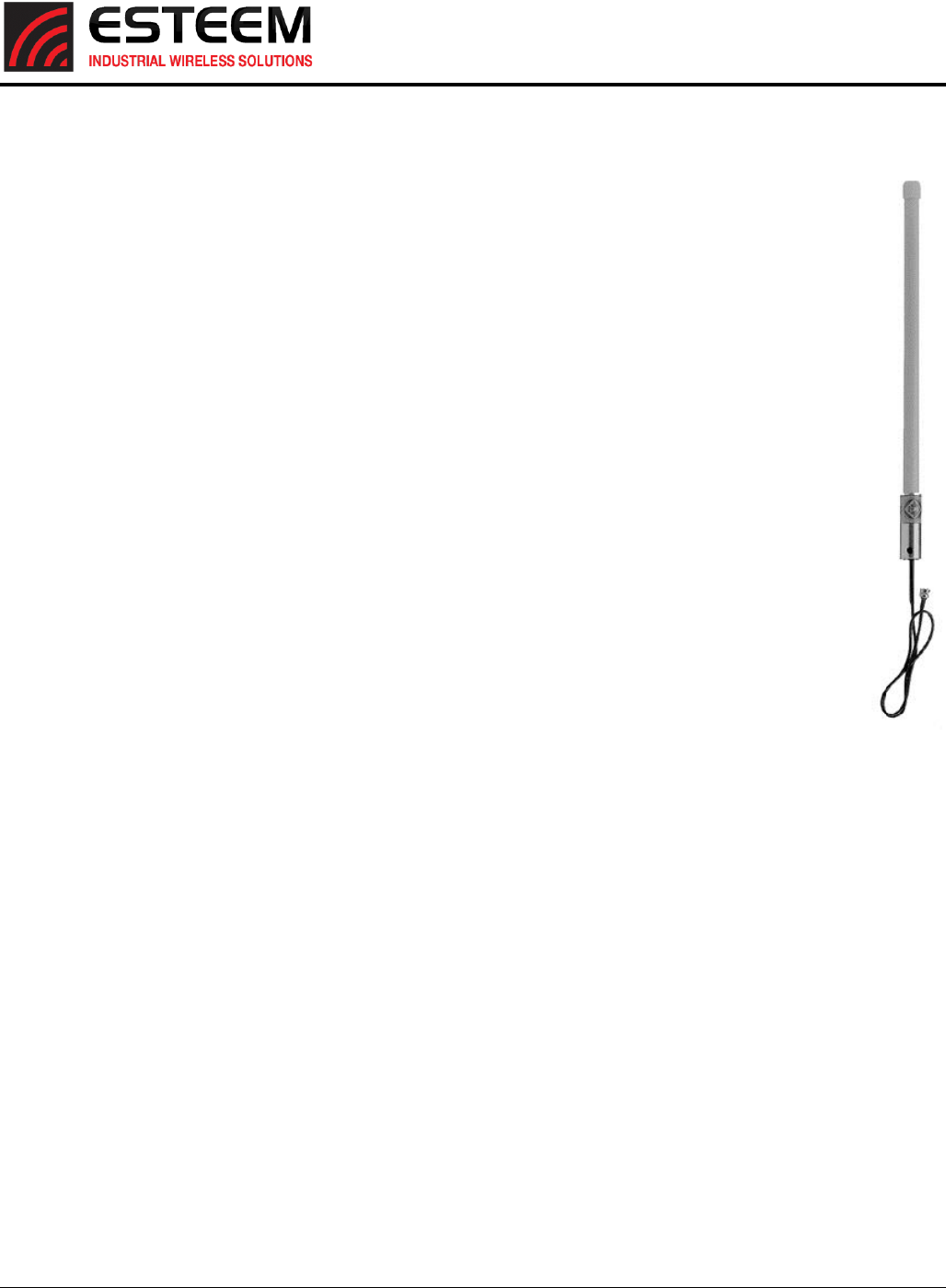
Edge 900
User’s Manual
Revised: 19 Jan 2017 8 of 9
Antenna Specifications
Model No: AA20Es900
Antenna Type: Omni Directional, DC Grounded
Applications: Fixed base
Frequency: 902 to 928 MHz
Polarization: Vertical
Impedance: 50 ohms
Gain: 7 dBi (5 dBd)
VSWR: 1.5:1 Typical
Front to Back Ratio: n/a
Horizontal Beamwidth: n/a
Vertical Beamwidth: 22 degrees @ ½ power
Antenna Material: Brass radiator, UV inhibited fiberglass enclosed
Mounting Hardware: Base to Mast, Supplied.
Maximum Power Input: 150 Watts
Wind Survival: 100 mph
Bending Moment: 14.2 ft-lbs. @ 100 mph
Antenna Connector: TNC-R Male with 36in. pig-tail.
Antenna Envelope: 48 in. L x 1-5/16 in. Dia.
Weight: 1.75 lbs.
Model AA20Es900
Caution
To comply with the FCC
exposure compliance
requirements, a separation
distance of at least 23 cm
must be maintained between
the antenna and all persons.
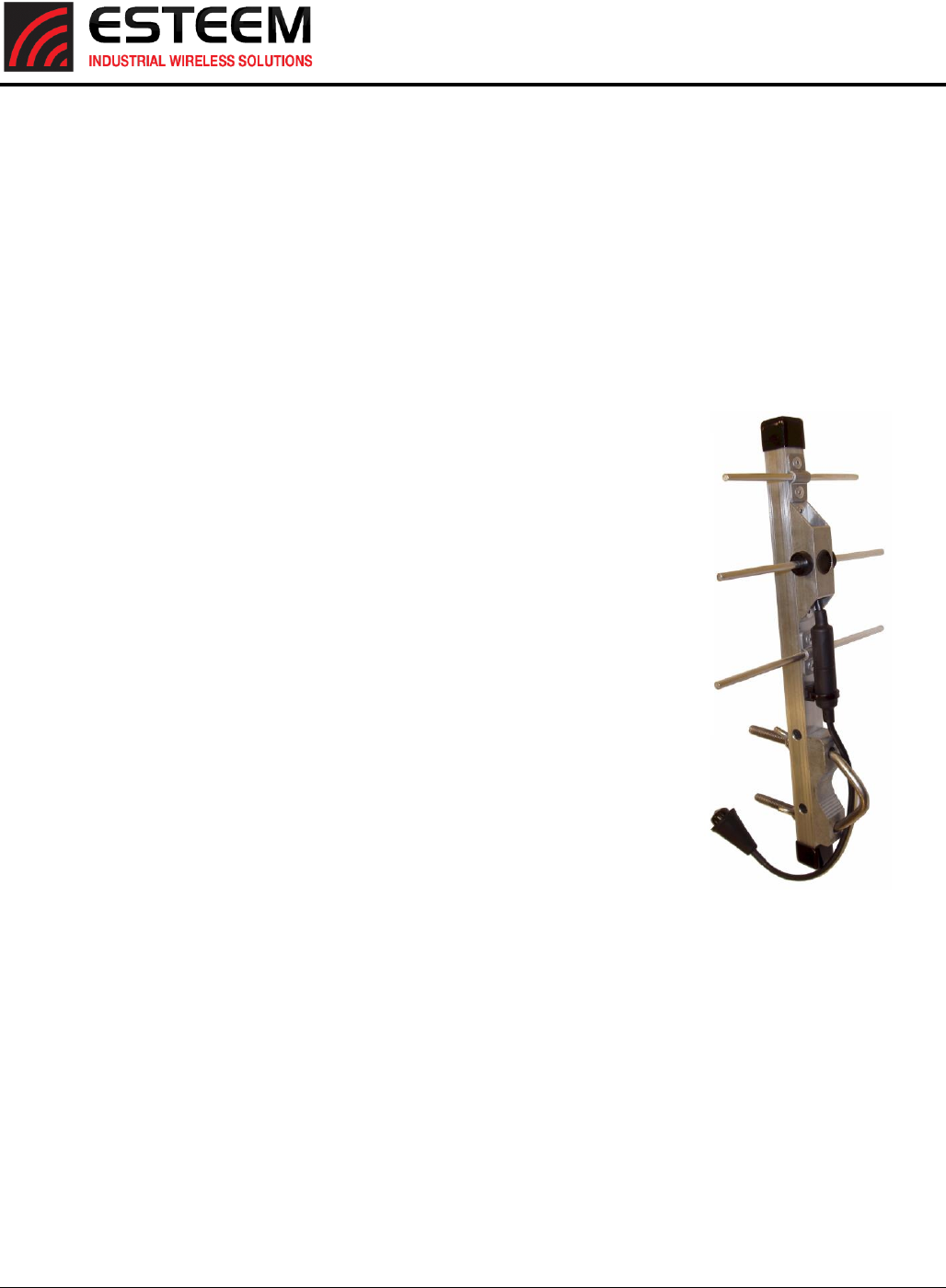
Edge 900
User’s Manual
Revised: 19 Jan 2017 9 of 9
Model No: AA203Es900
Antenna Type: Directional, DC grounded
Applications: Fixed base.
Frequency: 902 to 928 MHz
Polarization: Vertical or Horizontal
Impedance: 50 ohms
Gain: 7 dBi (5 dBd)
VSWR: < 1.5:1 Nominal
Front to Back Ratio: > 16 dB
Horizontal Beamwidth: 130 degrees @ ½ power
Vertical Beamwidth: 70 degrees @ ½ power
Antenna Material: Aluminum
Mounting Hardware: Heavy duty U bolts for mounting up to 2.0 in. pipe
(included).
Antenna Connector: TNC-R Male with 2 ft. pigtail with ESTeem
weatherproof boot.
Maximum Power Input: 50 Watts
Antenna Envelope: 1.1 ft. length by 6 in. width
Windload (RWV): 150 mph
Wind Surface Area: .11 ft²
Weight: 1 lbs.
Model AA203Es900
Caution
To comply with the FCC
exposure compliance
requirements, a separation
distance of at least 23 cm
must be maintained between
the antenna and all persons.